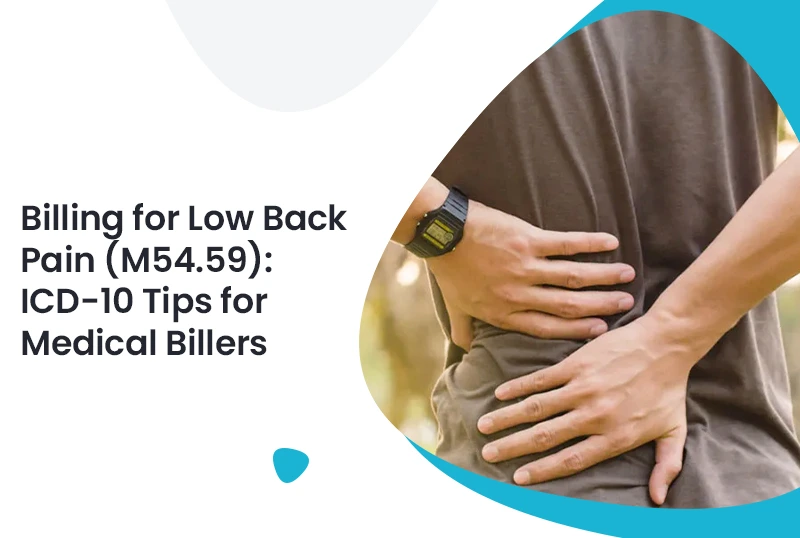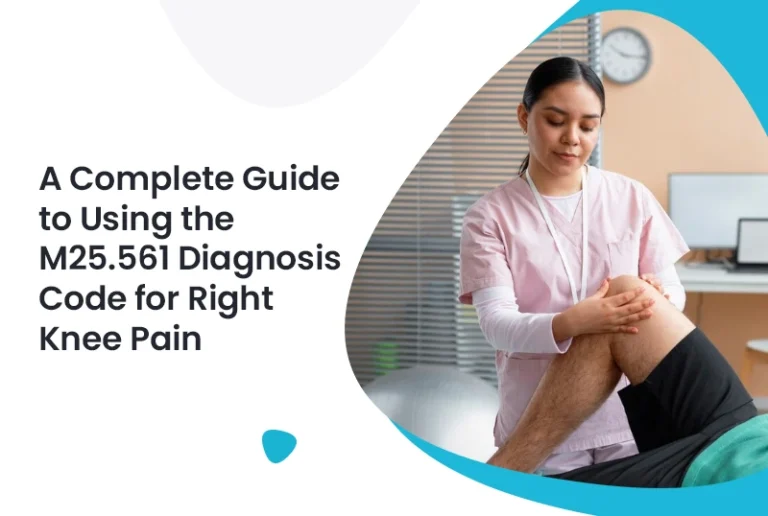Low back pain is one of the most frequent reasons patients visit healthcare providers. For medical billers, accurately coding and billing low back pain cases under the ICD-10 code M54.59 is essential to ensure timely reimbursement and reduce claim denials. This code, classified as “Other low back pain,” covers a wide range of low back pain diagnoses when the pain’s specific cause is not identified. Understanding how to use this code correctly, document thoroughly, and integrate efficient billing practices is key for successful claims.
Incorporating medical credentialing services plays a vital role in establishing provider legitimacy, which directly impacts the smooth processing of M54.59 claims and overall revenue cycle efficiency.
What is ICD-10 Code M54.59?
ICD-10 code M54.59 refers to “Other low back pain,” an unspecified low back pain condition that does not fall into more precise categories such as sciatica (M54.4) or lumbago with sciatica (M54.40). This code is appropriate when the patient experiences low back pain that lacks further diagnostic clarity.
This general classification helps billers submit claims when the provider documents low back pain without detailing a specific underlying pathology such as herniated discs or spinal stenosis.
Want more information? Read here: Accurate Billing for Abdominal Pain (R10.84) Using ICD-10 Codes
When to Use M54.59 for Billing
The use of M54.59 must be guided by accurate clinical documentation. Medical billers should verify that:
- The patient’s clinical notes clearly mention low back pain without a more specific diagnosis
- Imaging or diagnostic results do not indicate a different, more defined condition
- The pain is localized to the lumbar region without signs of radiculopathy or nerve involvement
- Providers have not assigned other ICD-10 codes for related spine conditions
Overuse of this unspecified code can trigger audits or claim denials, especially from payers emphasizing diagnostic specificity.
Importance of Proper Documentation
For successful billing of M54.59, providers must maintain detailed records including:
- Patient’s reported symptoms: nature, intensity, duration, and any aggravating or relieving factors
- Results from physical examinations focused on the lumbar spine
- Diagnostic imaging or tests ordered or reasons for not ordering them
- Treatment approaches, such as medications, physical therapy, or referrals
Complete documentation not only supports the use of M54.59 but also helps reduce claim rejections and facilitates faster reimbursement.
Working closely with Revenue Cycle Management (RCM) teams allows practices to regularly review documentation quality and coding accuracy, improving financial outcomes.
Common Challenges in Billing M54.59
Medical billers face several obstacles when coding and billing this low back pain diagnosis:
- Ambiguity: Lack of detailed diagnosis in provider notes can lead to payers requesting additional information.
- Incorrect Code Use: Submitting M54.59 when a more specific code is appropriate leads to denials or reduced payments.
- Multiple Conditions: Low back pain often coexists with other musculoskeletal issues, requiring careful code selection and modifier use.
- Denials from Payers: Insurers may challenge claims citing insufficient evidence or preference for more specific codes.
To address these issues, medical billers must verify documentation and clarify any discrepancies with providers before claim submission.
The Role of (MBC) in M54.59 Claims
Precise medical billing coding ensures claims reflect the patient’s clinical condition and comply with payer guidelines. When coding for M54.59:
- Validate that the diagnosis code matches the clinical notes exactly
- Use adjunct codes for related conditions when applicable (e.g., M54.5 for sciatica if documented)
- Apply appropriate CPT codes for services rendered alongside diagnosis codes
- Utilize modifiers correctly if multiple diagnoses or procedures affect billing
Billing accuracy avoids claim rejections, accelerates payments, and safeguards the provider’s revenue.
Leveraging Medical Credentialing Services
Medical credentialing verifies that healthcare providers are properly licensed, certified, and approved by insurance payers. This verification is crucial for claims involving M54.59 because:
- Credentialed providers reduce the risk of claim denials based on provider eligibility
- Credentialing supports compliance with payer rules and regulations
- It strengthens the credibility of claims submitted, improving acceptance rates
Outsourcing credentialing to experienced agencies helps practices maintain up-to-date provider status, which positively impacts revenue cycles and billing efficiency.
Best Practices for Medical Billers Handling M54.59
- Educate Providers: Regular training on proper documentation and code specificity reduces coding errors.
- Audit Claims: Implement internal reviews to catch under-coded or over-coded claims before submission.
- Stay Updated: Keep abreast of payer policies and ICD-10 coding updates related to low back pain.
- Communicate: Establish open communication channels between billing staff and clinicians to clarify coding questions.
- Use Technology: Employ billing software that flags incomplete notes or improper code use to minimize denials.
Following these guidelines creates a smooth billing process, resulting in fewer delays and denials.
How Revenue Cycle Management Improves M54.59 Billing
Efficient Revenue Cycle Management integrates clinical documentation, coding, claim submission, and payment follow-up into a seamless workflow. For M54.59, RCM processes help by:
- Ensuring claims meet all payer requirements before submission
- Monitoring denials and addressing root causes proactively
- Providing analytics to track coding accuracy and payment trends
- Managing provider credentialing to avoid administrative claim errors
Partnering with an RCM expert can significantly enhance the billing and collection process, reducing the time between service and payment.
Conclusion
Billing low back pain under ICD-10 code M54.59 requires a thorough understanding of documentation standards, precise coding, and effective revenue cycle management. Using this code correctly and supporting claims with detailed clinical notes improves the chances of claim approval and faster reimbursements.
Integrating medical credentialing services ensures provider eligibility and compliance, making claims more reliable and accepted by payers. By following best practices and leveraging technology, medical billers can optimize billing workflows for low back pain diagnoses.
For practices seeking to improve their billing efficiency and reduce claim denials, partnering with specialized service providers like Precision Hub is a strategic step toward financial stability and operational success.
(FAQs) Frequently Asked Questions
Q1: What does M54.59 stand for in ICD-10?
A: M54.59 stands for “Other low back pain,” used when the pain is unspecified and does not fit more precise diagnoses.
Q2: Can M54.59 be billed for both acute and chronic pain?
A: Yes, but documentation must clearly indicate whether the pain is acute or chronic for accurate billing.
Q3: How can I ensure my claims for M54.59 are accepted?
A: Accurate documentation, correct coding, and regular provider credentialing help ensure claims are approved.
Q4: What are common reasons for denials of M54.59 claims?
A: Denials often occur due to insufficient documentation, use of unspecified codes when more specific ones apply, or provider credentialing issues.
Q5: How does revenue cycle management help with M54.59 billing?
A: It streamlines claims processing, reduces denials, manages documentation audits, and ensures timely reimbursement.







